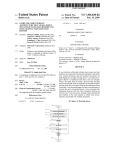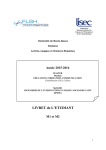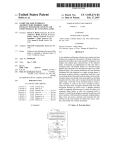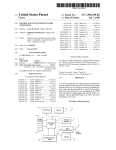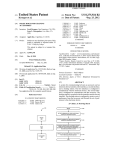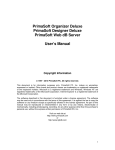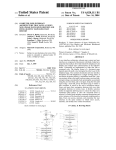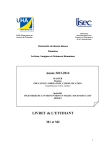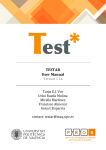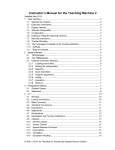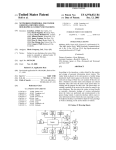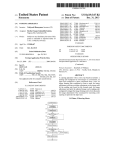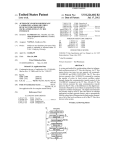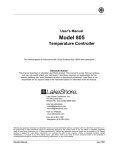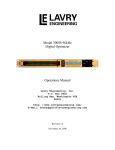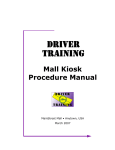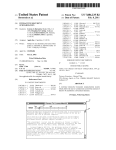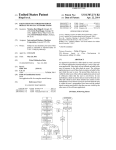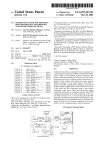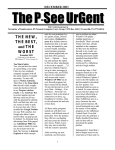Download Computer user interface architecture wherein both content and user
Transcript
US007458014B1 (12) Unlted States Patent (10) Patent No.: Rubin et a]. (54) US 7,458,014 B1 (45) Date of Patent: COMPUTER USER INTERFACE ARCHITECTURE WHEREIN BOTH 5,239,466 A RE34,476 E CONTENT AND USER INTERFACE ARE Nov. 25, 2008 8/1993 Morgan et a1. 12/1993 NorWood (Continued) COMPOSED OF DOCUMENTS WITH LINKS FOREIGN PATENT DOCUMENTS (75) Inventors: Darryl E. Rubin, Redmond, WA (US); / Andrew C. Baird, Kirkland, WA (US); EP John L. Beezer, Redmond, WA (US); Jonathan C. Cluts, Redmond, WA (US); (73) _ (21) (52) Crespo et al., “Responsive interaction for large Web application: the meteor shower architecture in the WebWriter II Editor,” Computer Networks and ISDN System, 1997, pp. 1507-1517.* Subject to any disclaimer, the term of this patent is extended or adjusted under 35 (Continued) Primary ExamineriDOug Hutton U'S'C' 154(1)) by 0 days‘ Assistant ExamineriMaikhanh Nguyen 74Azz A z F'iShkHd&B (LL)P Omey’ gen ’ or Wm 00 ’ at y acon’ Appl. No.: 09/457,109 (22) Filed: (51) OTHER PUBLICATIONS _ Asslgnee: Mlcrosoft corporatlom Redmond: WA (US) ( * ) Notice: 11 1989 (Continued) Susan D. Woolf, Seattle, WA (US) _ 0342838 A Dec. 7, 1999 (57) ABSTRACT Int‘ Cl‘ A user interface architecture Wherein user content and user G06F 1 7/00 (200601) G06F 15/177 (200601) US. Cl. ..................... .. 715/229; 715/207; 715/234; 715/240; 715/752; 709/206 interface are composed of documents With links is described. Links have properties that indicate hoW links should be dis played Link display may depend upon Characteristics Ofthe linked-to frame. Commands are implemented as links that (58) Field of Classi?cation Search ............ .. 715/500.1, ?nk to Command Code, The display format of a document (56) 715/501-1, 513, 511, 516, 526, 200, 201, 715/205, 207, 226, 229, 234, 240, 251, 255, 715/273, 277, 738, 752, 760, 762, 804, 805, 715/851; 345/738; 709/ 201, 203, 206; 707/ 1, 707/10, E17-1 11 See application ?le for Complete Search historyReferences Cited page depends upon the path a user navigated in order to get to the displayed page. User content documents and user inter face documents are both displayed in a single vieWing frame. A non-linear navigation history is maintained such that a user can navigate along a ?rst path, back up using a previous link, navigate along a second path, back up along the second path us1ng the prev1ous l1nk, and re-nav1gate along the ?rst path again using a next link. Every document page to Which a user U.S. PATENT DOCUMENTS 5,146,552 A 5,237,648 A navigates is saved in the user’s navigation history. 9/1992 Cassorla et al. 8/1993 Mills et al. 21 Claims, 11 Drawing Sheets get the next link in the current display state examine the link’s display properties display a frame based on the links properties display linked-to content’! US 7,458,014 B1 Page 2 US. PATENT DOCUMENTS 5,347,295 5,390,138 5,434,929 5,434,965 5,471,568 5,559,942 5,623,679 5,625,833 5,630,125 5,632,022 5,644,674 5,666,113 5,680,636 5,682,439 5,687,331 5,689,717 5,717,860 5,717,879 5,719,595 5,727,129 5,729,687 5,737,599 5,745,116 5,760,773 5,761,485 5,761,683 5,784,058 5,786,814 5,790,818 5,801,685 5,801,687 5,802,516 5,819,301 5,821,925 5,822,720 5,826,025 5,832,263 5,835,092 5,838,313 5,838,914 5,845,262 5,854,630 5,860,074 5,862,395 5,893,126 5,893,132 5,903,729 5,918,236 5,920,694 5,923,326 5,924,104 5,931,912 5,933,139 5,933,140 5,937,416 5,940,080 5,948,040 5,950,214 5,956,034 5,956,048 5,978,818 5,982,370 5,983,248 5,986,665 6,011,537 6,012,055 6,018,334 6,018,342 6,018,344 6,018,742 6,025,841 9/1994 2/1995 7/1995 7/1995 11/1995 9/1996 4/1997 4/1997 5/1997 5/1997 7/1997 9/1997 10/1997 10/1997 11/1997 11/1997 2/1998 2/1998 2/1998 3/1998 3/1998 4/1998 4/1998 6/1998 6/1998 6/1998 7/1998 7/1998 8/1998 9/1998 9/1998 9/1998 10/1998 10/1998 10/1998 10/1998 11/1998 11/1998 11/1998 11/1998 12/1998 12/1998 1/1999 1/1999 4/1999 4/1999 5/1999 6/1999 7/1999 7/1999 7/1999 8/1999 8/1999 8/1999 8/1999 8/1999 9/1999 9/1999 9/1999 9/1999 11/1999 11/1999 11/1999 11/1999 1/2000 1/2000 1/2000 1/2000 1/2000 1/2000 2/2000 Agulnick et al. Milne et al. Beernink et al. Matheny et al. Webb et al. Gough et al. Rivette et al. Levine et al. Zellweger Warren et al. Aihara et al. Logan Levine et al. Beernink et al. Volk et al. Pritt Graber et al. Moran et al. Hoddie et al. Barrett et al. Rothrock et al. Rowe et al. Pisutha-Arnold Berman et al. Munyan Logan et al. .... .. .. LaStrange et al. ......... .. 715/738 Moran et al. Martin Miller et al. Peterson et al. Shwarts et a1. Rowe et al. Carey et al. Bookman et al. Gramlich Hansen et al. Boudreau et al. Hou et al. Carleton et al. NoZue et al. Nielsen Rowe et al. Bier Drews et al. Huffman et al. Reber et al. ............... .. 709/219 Wical Carleton et al. Bittinger et al. Earl ...................... .. 715/501.1 Wu et al. Feigner et al. Strahorn et al. MenZel Ruehle et al. DeLorme et al. Rivette et al. Sachs et al. Gaston Lin Kamper DeRose et al. Wrey et al. SlotZnick Campbell et al. Eckerberg et al. Bristor ..................... .. 715/840 Harada et al. Herbert, III Finkelstein et al. 6,034,689 6,035,330 6,037,934 6,038,598 6,049,812 6,052,514 6,054,990 6,055,538 6,064,384 6,072,490 6,076,917 6,081,829 6,091,930 6,094,197 6,105,044 6,122,649 6,133,925 6,141,007 6,144,375 6,144,991 6,151,622 6,154,771 6,157,381 6,163,778 6,181,344 6,184,886 6,195,679 6,195,694 6,199,082 6,205,419 6,205,455 6,211,871 6,226,655 6,230,171 6,243,071 6,243,091 6,266,772 6,272,484 6,279,014 6,289,126 6,289,362 6,301,590 6,320,169 6,320,577 6,321,242 6,321,244 6,331,866 6,331,867 6,340,980 6,356,287 6,369,811 6,370,497 6,377,983 6,389,434 6,393,422 6,397,264 6,405,221 6,418,421 6,421,065 6,425,525 6,437,793 6,437,807 6,446,110 6,457,013 6,484,156 6,486,895 6,490,603 6,529,920 6,535,294 6,539,370 6,549,220 6,549,878 6,560,621 > 3/2000 3/2000 3/2000 3/2000 4/2000 4/2000 4/2000 4/2000 5/2000 6/2000 6/2000 6/2000 7/2000 7/2000 8/2000 9/2000 10/2000 10/2000 11/2000 11/2000 11/2000 11/2000 12/2000 12/2000 1/2001 2/2001 2/2001 2/2001 3/2001 3/2001 3/2001 4/2001 5/2001 5/2001 6/2001 6/2001 7/2001 8/2001 8/2001 9/2001 9/2001 10/2001 11/2001 11/2001 11/2001 11/2001 12/2001 12/2001 1/2002 3/2002 4/2002 4/2002 4/2002 5/2002 5/2002 5/2002 6/2002 7/2002 7/2002 7/2002 8/2002 8/2002 9/2002 9/2002 11/2002 11/2002 12/2002 3/2003 3/2003 3/2003 4/2003 4/2003 5/2003 White et al. AstiZ et al. Himmel et al. Danneels .................. .. 709/219 Bertram et al. Gill et al. Tran Kessenich et al. Ho Bates et al. Wen Sidana Mortimer et al. BuXton et al. DeRose et al. Kanerva et al. ........... .. 715/516 Jaremko et al. ........... .. 345/441 Lebling et al. Jain et al. England Fraenkel et al. ........... .. 709/205 Rangan et al. Bates et al. Fogg et al. .................. .. 707/10 Tarpenning et al. Bates et al. Bauersfeld et al. Chen et al. Ferrel et al. Fielder Umen et al. Himmel et al. Borman et al. ......... .. Paci?ci et al. Shwarts et al. Berstis Suzuki 715/501.1 ..................... .. 713/182 Martin et al. Schilit et al. Ishisaka Van Der Meer Siow et al. Clothier Alexander Fogg et al. ................ .. 715/513 Liu et al. Eisenberg Eberhard et al. Ho Ruberry et al. Graham et al. Knowles ...................... .. 704/1 Cohen et al. Rivette et al. Wone Stasnick et al. Levine et al. Hurtado et al. Walden et al. Swaminathan et al. Kaasila Berquist et al. Lection et al. Saxton et al. ............. .. 707/101 Gupta et al. ................. .. 707/1 Robertson et al. Keenan et al. Arons et al. ........... .. 715/500.1 Arledge, Jr. et al. Chang et al. Hsu et al. ................. .. 715/854 Lowry et al. Barile US 7,458,014 B1 Page 3 6,571,211 B1 5/2003 Dwyeretal. Kuo et al., “A Synchronization Scheme for Multimedia Annotation”, 6,571,295 B1 6,573,907 B1 5/2003 Sidana 6/2003 Madrane Multimedia Information Networking Laboratory, Tamkang Univer sity- Taiwan, IEEE, 1997, pp. 594-598. “Huckle?ne De?ned”, Apr. 1990, “http://www.ylem.org/artists/ 6,585,776 B1* 6,636,238 B1 6,647,534 B1 6,662,310 B2 7/2003 Bates et al. ............ .. 715/501.1 10/2003 Amir et al. 11/2003 Graham 12/2003 Lopez et al. Lapstun et al. ............ .. 382/187 mmosher/huck.html”, pp. 1-3. “Tour of Korea Hypercard Stack”, 1996, Grose Educational Media, “http://www.entrenet.com/~groedmed/kor2.html”, pp. 1-2. BiZweb2000.comiscreenshots of an e-book, published on May 6,681,045 B1 * 1/2004 6,687,878 B1 2/2004 Eintracht et al. 1999, 6,697,997 B1* 2/2004 Fujimura ............... .. 715/501.1 biZweb2000.com/eshots.htm”. “Adobe Acrobat 3 .0 Reader Online Guide”, Adobe Systems, Inc., pp. 1-1 10. 6,710,790 B1 3/2004 Fagioli 6,714,214 B1 6,760,884 B1 3/2004 DeMello 7/2004 Vertelney et al. 6,766,494 B1* 6,772,139 B1* 6,788,316 B1* 7/2004 8/2004 9/2004 6,871,318 B1 6,976,035 B1 * 2001/0031128 A1 Price et al. ................ .. 715/513 Smith, III .................... .. 707/3 Ma et al. .................. .. 715/739 3/2005 Wynblatt et al. 12/2005 Lapstun et al. ............ .. 707/200 10/2001 Manbeck 2002/0013834 A1* 1/2002 2002/0097261 2002/0099552 2002/0194260 2005/0060138 7/ 2002 Gottfurcht et al. 7/ 2002 Rubin et al. EP W0 W0 W0 W0 W0 W0 A1 A1 A1 A1 Esakov et al. ............. .. 709/223 12/2002 Headley et al. 3/2005 Wang et al. pp. 1-4 “http://web.archive.org/web/*/http://www. KunikaZu, T., Patent Abstracts of Japan, Publication No. 11327789 for Color Display and Electronic Blackboard System, published Nov. 30, 1999. Open eBook Forum, Open eBookTM Publication Structure 1.0, http:// www.ebxwg.org/oebps/oebps1.0/download/oeb1-oebps.htm. Kristensen, A., “Formsheets and the XML Forms Language” (Mar. 1999). Dublin Core Resource Types: Structurality DRAFT: Jul. 24, 1997, (Feb. 27, 1998). Dublin Core Metadata Element Set, Version 1.1: Reference Descrip tion (1999). Dublin Core Metadata Initiative: User Guide Working Draft Jul. 31, FOREIGN PATENT DOCUMENTS 1998 (1999). Marshall, C., “Annotation from paper books to the digital library,” 0 822 501 A1 WO 87/01481 WO 96/20908 W0 97 22109 A WO 98/06054 WO 98/09446 WO 99/49383 ACM International Conf. on Digital Libraries, 1997, pp. 131-140. “Joke eBook,” Jul. 1998, PrimaSoft PC, Inc., Electronic Book Series Version 1.0, pp. 1-5. Munyan, D., “Everybook, Inc: Developing the E-Book in Relation to 2/1998 3/1987 7/1996 6/1997 2/1998 3/1998 9/1999 OTHER PUBLICATIONS Schilit and Price: “Digital Library Information Appliances”, ACM Conference on Digital Libraties, Jun. 23, 1992, pp. 217-226. Graefe, et al: “Designing the muse: A Digital Music Stand for the Symphony Musician”, Proc. of Conf on Human Factors In Comput ing Systems, Apr. 13-18, 1996, pp. 436-441. Softbook® Press The Leader in Internet-Enabled Document Distri bution and Reading Systems; http://www.softbook.com/consumer/ reader.asp, 1999. Rocket eBook Using the Rocket eBook; http://www.rocketbook. com/Products/Faq/using.htrnl, 1999. Explore the Features of the Rocket eBook; wysiwyg://212http:// www.rocketbook.com/Products/Tour/index.htrnl, 1999. Crespo, Chang, Bier: Computer Networks and ISDN Systems Publishing Standards,” Sep. 1998, http://www.futureprint.kent.edu/ articles/munyan01.htm, pp. 1-7. Greenberg, Saul, “A Fisheye Text Editor for Relaxed-WYSIWIS Groupware”, Chi 1996 Proceedings, pp. 1 to 5. C. Marshall, “Annotation from paper books to the digital library,” ACM International Conf. on Digital Libraries, 1997, pp. 131-140. D. Munyan, “Everybook, Inc: Developing the E-Book in Relation to Publishing Standards.” Sep. 1998, http://www.futureprint.kent.edu/ articles/munyan0.1htm, pp. 1-7. PhotoImpact 3.0, Ulead Systems Inc., 1996. Landay et al., “Making Sharing Pervasive: Ubiquitous Computing for Shared Note Taking,” IBM Systems Journal, vol. 38, No. 4, 1999, pp. 531-550. Landay, J. A., “Using Note-Taking Appliances for Student to Student Collaboration,” 29th Annual Frontiers in Education Conference, IEEE Computer Society, Nov. 1999, p. Session 12C4/15-12C4/20. Dublin Core Resource Types: Structurality Draft: Jul. 24, 1997, Feb. 27, 1998. Dublin Core Metadata Element Set, Version 1.1: Reference Descrip “Responsive interaction for a large Web application: the meteror shower architecture in the WebWriter II Editor”, 1997, pp. 1508 tion 1999. 1517. Dublin Core Metadata Initiative: User Guide Working Draft Jul. 31, Hirotsu et al. “Cmew/UiA Multimedia Web Annotation Sharing 1998 1999. System”, NTT Network Innovation Laboratories- Japan, IEEE, 1999, pp. 356-359. * cited by examiner US. Patent Nov. 25, 2008 Sheet 2 0f 11 US 7,458,014 B1 .wEN Now/ / i| \mow 1C9W%2; US. Patent Nov. 25, 2008 Sheet 3 0f 11 300 US 7,458,014 B1 302 get defaulL/ state Yes ¢_____ display state —\ 306 308 310 x[\determine nature of user input 312 x \determine region of user input 314 \ determine object associated with \ region 316 —\ determine action based on input \ and object \ perform action FIG. 3 US. Patent Nov. 25, 2008 40/0 Sheet 4 of 11 US 7,458,014 B1 I begin ) FIG. 4 Y ( get the next link in the current display state 402 l T examine the link’s display properties 404 Al display a frame based on the link’s properties No display linked-to content? 408 examine link target I V (‘ display link in frame 41 2 416 more No links in Yes the current 414 US. Patent .360? Nov. 25, 2008 Sheet 5 0f 11 US 7,458,014 B1 8.35 L.1.1: .. ?z-s1unbr. Mm3LPust;oEm mLOE 3mF1-H0ZE g 250 dug MSE352.D:S ULOE US. Patent N v. 25, 2008 44.1.1.1. WWW sof:St8m2 Q550.5 Sheet 6 0f 11 US 7,458,014 B1 US. Patent Nov. 25, 2008 0.U,1,,0 1 .m.SEPmELmE: Em53x8,“ Sheet 7 0f 11 US 7,458,014 B1 252%.18w23ax.m26,Q2Em55m:umF»,m;E @EN 1$3,11$w,00306 was. [email protected] 1% //o2. US. Patent Nov. 25, 2008 Sheet 8 0f 11 US 7,458,014 B1 ml 1) 02s:a2:5392.16 vMu@:awc3ri2gmtes5a?,.u)“s >m3H:wa52umn.c2w8a,m»;n mdcwgb#5i6a&Qu.SZg3E:H mPMWFB2EuQ5AE3Ngm.tMS:E25 28E:23s22E2:am tac mn.» US. Patent Nov. 25, 2008 .. £8230%? a5as55i=2mm2HM8% ,, Sheet 10 0f 11 1..; u . u US 7,458,014 B1 US 7,458,014 B1 1 2 COMPUTER USER INTERFACE ARCHITECTURE WHEREIN BOTH CONTENT AND USER INTERFACE ARE COMPOSED OF DOCUMENTS WITH LINKS properly saved. Accordingly, there is a need to provide a save-less model, so that users do not need to explicitly save their Work. Users of prior art UIs typically do not have a convenient and seamless Way to record notes verbally and to associate notes With particular parts of a document. Accordingly, there is a need to provide rich support for audio note taking With the TECHNICAL FIELD This invention relates generally to computer user interface architectures. More particularly, the invention provides a user ability to correlate and synchroniZe audio and textual material interface architecture in Which both user content and user 10 Prior art device-to-device and device-to-PC synchroniZa tion schemes typically are not seamless and require a great deal of con?guration and attention from the user. Accord ingly, there is a need to provide automatic and transparent and to revieW and retrieve audio notes. interface are composed of document pages With links. BACKGROUND OF THE INVENTION synchronization betWeen a user’s computers, such as a hand Many personal computer users ?nd the desktop metaphor held computer and a desktop computer. In prior art UIs, methods for getting help are currently separate from the content and often require completely dif ferent interactions than interacting With content. Accordingly, of prior art computer user interfaces (“UIs”) confusing and dif?cult to learn. Accordingly, there is a need for a system that simpli?es the user’s interaction With the computer by using feWer kinds of user interface controls in a more general Way. Further, the Ways in Which users interact With information about prior UIs is different than the Way the user interacts With content, such as documents, presentations, and the like. For example, in prior art UIs, content and UI information are 20 heart of their interface metaphors, Which makes sharing con tent and annotations With other users dif?cult and non-intui displayed entirely differently. Content is typically displayed in a particular region or frame of the display. User interface information is never displayed there. Instead, user interface there is a need to make the process of getting help about a function the same as the process for carrying out the function. Prior art UIs typically have a “single-user model” at the tive. Accordingly, there is a need to make sharing and col 25 laborating on documents easier and more automatic. information is displayed in dialog boxes, drop doWn menus, SUMMARY OF THE INVENTION and tool bars. User content never shoWs up in dialog boxes, drop doWn menus, and tool bars. Similarly, users ?nd user According to various preferred embodiments, the inven content documents and UI help information differently. 30 tion includes a user interface architecture in Which user con Accordingly, there is a need for a UI architecture in Which the concepts and actions the user must learn are the same for interacting With both content and the UI. Such a uni?cation makes computer softWare easier and more e?icient to use. Prior art UIs for desktop computers typically require a tent and user interface are composed of documents With links. A link can relate a spot or region in a document With a spot or region in another document, so that touching the link causes the display to navigate to that other document. A link can also 35 keyboard and mouse in order for a user to interact With them, relate a spot or region in a document and an active runable object such that When a user activates that link or touches that and most pen-enabled palmtop computers have cumbersome spot in the document, the associated object is run. Parameters means of interaction. Therefore, there is a need for more for the execution of the object may be supplied by properties “natural” styles of interacting With a computer by using a minimum number common gestures such as touch, hold, associated With the link. Links, therefore, can act as com 40 erase, draW or Write. Prior art UI desktop metaphors applied to small form factor devices are typically cluttered and di?icult to use. In addition, applications that provide rich functionality are sometimes constrained by the limited ability of a user to navigate menus 45 and dialogs of prior art UIs. For instance, for such applica tions, the menus and tool bars may get too big, and the help system may get too cumbersome to navigate or search. Accordingly, in addition to the need for a simpler more uni ?ed experience for the user of an application, there is also a need to facilitate the uncluttered presentation of user inter The path a user takes to reach a document typically affects the behavior and presentation of the document. State-like information for displaying a linked-to document page is stored separately from the linked-from and linked-to docu Usability data for prior art UIs shoW that users of multi WindoWed systems don’t alWays knoW Which actions Will 55 reduce the complexity and confusion sometimes caused by multi-WindoWed user interfaces. Prior art UIs typically offer limited capabilities for custom iZing the UI. Accordingly, there is a need for a UI architecture that provides greater ?exibility to users, content developers, 60 and third-party softWare developers by providing broader capabilities for easily customiZing the UI. For example, dif ferent groups of users may be of different levels of computer skill and have need of different sets of features, and the UI can be customiZed to better suit their needs. Users of prior art UIs sometimes become extremely frus trated When their Work is lost because their Work Was not properties. Links can look like not only clickable spots, but also ?ll-in ?elds and other kinds of Well-knoWn and later developed user interface elements. Alternatively, links can manifest in the containing document a frame displaying the contents of part, or all, of the linked-to document. When links are displayed, in addition to basing the display format of the link on the link’s display properties, the link display format may depend upon the characteristics of the linked-to docu 50 ment. faces for applications providing very rich functionality. produce results in Which WindoW. Therefore, there is a need to mands. Links may be to any kind of command code. A link may manifest in various Ways based on the link’s ments as part of the link’s properties. Users access, interact With, and navigate among both user content documents and user interface documents in a uni?ed Way, namely, by acti vating links. Further, both user content document pages and user interface document pages are displayed in a single vieW ing frame. This uni?ed approach simpli?es the user’s inter action With both user content and user interface documents by reducing the number of concepts a user must learn in order to access, interact With, and modify both user content docu ments and the user interface. 65 A non-linear navigation history is maintained such that a user can navigate along a ?rst path, back up using a previous link an appropriate number of times, navigate along a second US 7,458,014 B1 4 3 path, back up along the second path using the previous link an appropriate number of times, and re-navigate along the ?rst FIG. 10 depicts an example of inked annotation displayed on a personal vieWer according to a preferred embodiment of the invention. FIG. 11 depicts an example End Page displayed on a per sonal vieWer according to a preferred embodiment of the invention. path again using a next link. Every document page to Which a user navigates is saved in the user’ s navigation history. Users can query their navigation histories and vieW their navigation history in various Ways, such as: by time, by appearance, by site, document, section, page, and the like. User can also vieW their navigation history as nodes With side tracking branches, DETAILED DESCRIPTION OF THE INVENTION as a linear list, or as a combination of most recently vieWed pages and last feW task categories. According to a preferred embodiment, navigation from user content pages through Introduction user interface pages that results in a command being executed Clutter-Free and Simple is automatically removed from the user’ s vieW of the naviga The UI architecture of this invention, also referred to herein tional history in order to keep the navigational history vieW as a “documents-With-links UI,” supports creation of UI’s uncluttered. A ?exible selection model is supported alloWing users to select the object of a command either before or after the command itself is selected. This ?exible selection model alloWs UIs built according to the principles of this invention to scale to small display areas. UIs built according to the that have essentially Zero clutter, and feW concepts to master. In this Way, it is a major departure from prior art UI’ s using a desktop metaphor. The user of a documents-With-links UI according to this invention focuses primarily on content and not on UI appurtenances. Starting With just knoWledge of hoW 20 to page through a document and to folloW links, a user can principles of this invention also scale Well to applications having voluminous and/or complicated user interfaces by learn hoW to do any other UI operation. Signi?cantly, the documents-With-links UI Works Without drop-doWn menus, facilitating an organiZed and uncluttered vieW of the user interface command hierarchy and/ or user interface help infor toolbars, WindoWs, or other cluttering UI elements (although mation for such applications. some of these elements may optionally be made available 25 Content and UI are Uni?ed Users get at commands by navigating to a page Where the desired command is found. In a preferred embodiment, the documents-With-links UI according to the principles of this invention is organiZed to make frequently used commands a single navigation step aWay, or through customiZations, no steps aWay. A self-explanatory document, the Guide Book is provided. The Guide Book is a readable manual that users can go through in a logical order, a page at a time, like any conventional user manual. Each command mention, hoWever, is an active command instance that can be invoked in place. In the UI architecture of this invention there is essentially no distinction betWeen UI pages and content pages. “UI” and “content” are the same thing, and exist in the same navigation 30 35 UI and content Webs. The one-space model is also more poWerful and customiZable, as described in more detail the appended claims. 40 FIG. 1 is a schematic diagram of a conventional general purpose digital computing environment that can be used to contents displayed on a personal vieWer according to a pre ferred embodiment of the invention. FIG. 7 depicts example Guide Book pages displayed on a personal vieWer according to a preferred embodiment of the invention. 45 tions in context, Without navigating to UI pages. The user gets the best of terse command access plus the richness of the full broWser and ansWer system for exploring the command set. The documents-With-links UI uses a Web architecture, With UI shortcuts layered on top. A nai've user Will typically start 50 by using the documents-With-links UI Without the short cutsithat is, by using the Guide Book to access UI functions. An advanced user Will typically be able to perform all com mon operations via the shortcuts and Without resorting to the documents-With-links UI Guide Book as often. 55 Scalability to Various Display SiZes and Types Various preferred embodiments of the documents-With links UI Will be explained beloW in the context of a portable “personal vieWer” platform. Nevertheless, the documents With-links UI is scalable across a Wide range of device and 60 display types from desktop computers to laptops to hand-held devices. Accordingly, the documents-With-links UI is intended to be implemented on any type of computing plat form. The documents-With-links UI exploits a large screen by FIG. 8 depicts example Quick Help pages, one of Which is bookmarked, displayed on a personal vieWer according to a preferred embodiment of the invention. FIG. 9 depicts an example of a pinned user content page displayed on a personal vieWer according to a preferred embodiment of the invention. beloW. Shortcuts Numerous UI shortcuts and direct manipulations may exist as a con?gurable layer on top of the documents-With-links UI, so more experienced users can do the most common opera implement various aspects of the invention. FIG. 2 shoWs a conventional tablet and stylus-based com as the same thing in a uni?ed navigational context. Because there is no seam betWeen UI and content, no notion of “dual” spaces, the documents-With-links UI is con ceptually simpler for the user than a model that has separate apparent through the folloWing description, the ?gures, and puter that can be used to implement various aspects of the invention. FIG. 3 is a ?owchart shoWing simpli?ed steps at a high level of abstraction for implementing a UI architecture according to the principles of this invention upon start up. FIG. 4 is a ?oW chart shoWing simpli?ed steps for imple menting the “display state” step of the ?oW chart in FIG. 3. FIG. 5 depicts an example Start Page displayed on a per sonal vieWer according to a preferred embodiment of the invention. FIG. 6 depicts an example book cover page and table of space. As described in more detail beloW, smart next/previous logic and intelligent management of the navigation chain solve technical problems caused by treating “UI” and content Other features and advantages of the invention Will become BRIEF DESCRIPTION OF THE DRAWINGS Where they are desired) being able to shoW content in a book-like WayitWo full 65 side-by-side pages, as depicted, for instance, in FIG. 8. UI, being content, takes advantage of the large format of pages and the ability to turn/navigate pages (versus the smaller siZe US 7,458,014 B1 5 6 of menus/dialog boxes in prior art Uls and their limited or code. Scripts are one example. Binary code objects are another example. As a result, pages that have links replace the drop-doWn menus and dialog boxes of prior art Uls. nonexistent provisions for navigation). At the other end of the spectrum, the UI scales to small screens because of the ?exible selection model that alloWs command selection regions to be initiated either before or after the desired command is chosen. This means, for A link may manifest in various Ways based on the link’s example, that on a small screen a user can call up a page of properties. Links can look like not only clickable spots, but also ?ll-in ?elds and other kinds of Well-knoWn and later developed user interface elements. A document page could command choices that completely obscure the original docu have these other kinds of active elements that are really a form ment due to screen siZe limitations, choose the command, then return to the user document and then select the region for of link. Accordingly, activating links goes beyond merely the command to operate on. Suppose a user Wanted to refor mat some text, but had not selected the text to be reformatted yet. The user could press a link that indicates that it Will ?elds, pressing radio buttons, and the like. Again, pages With links replace prior art dialog boxes having buttons and the clicking on colored underlined text and can include ?lling in like. The links may look like buttons, but the links are simply links. reformat text. The UT of this invention Will display an indica tor on the screen prompting the user to select the text to be Even the desktop metaphor of ?les and folders is expressed reformatted. After selecting the text, the user can ?nish the as lists of links on a page. Additionally, links have properties that govern their appearance and behavior. For example, a link’s properties may dictate that it appear as a blue under scored text string as in prior art broWsers, or as a 3D button, as a graphic icon, as a thumbnail image of the content being reformatting operation by clicking on another link, such as a link that indicates that the selected text Will be reformatted. Alternatively, the user could select the region ?rst and then go ?nd and invoke the command. Being able to select the object upon Which a command Will operate after selecting the com mand is unlike the selection model of prior art U’s Where object selection must precede command selection. The selec tion model of the documents-With-links Ul is discussed in more detail beloW. 20 linked to, or even as an embedded frame that is open on the content being linked to. As described in more detail beloW, a user can modify hoW 25 General Concepts Underlying the Documents-With-Links Ul content and the user interface. Architecture No Distinction BetWeen Content Documents and UI Docu ments Actions in a U1 according to the principles of this invention 30 The basic principle of the documents-With-links Ul is that everything the user sees and interacts With is a document. This occur by clicking on commands that exist on pages. To the user, a command looks like a link, and in fact it is a link. Speci?cally, a command is a link Whose source anchor is the command hotspot, Whose destination anchor is the script or code that implements the command, and Whose properties are applies equally to both content and UI. These documents could be implemented in HTML, XML, and the like. There is essentially no difference betWeen content and UI documents. a link manifests by modifying the link’s properties. The abil ity to control a link’s appearance and behavioral properties makes possible rich authoring and customization of both 35 In fact the same document can mix content and UI. Even though some Ul elements like context menus and toolbars the command parameters. Some commands may run With canned parameters While others may present users With a form for entering the parameters (for example, the Properties may be presented in Ways that do not look document-like, command). they are in fact implemented as documents and can be manipulated as such. The uniform treatment of content and “UI” pages is impor Because a command is a link, it has all the functionality of links. For example, commands can visualiZe in multiple 40 Ways, such as an underlined blue label, a button, an icon, or a graphic image. They can be copied from one place to another, moved, and deleted. Their properties can be manipulated, tant for several reasons: Users only need to deal With one set of navigation controls and conventions, and only one navigation space. Users never need to think about Whether they are in content space or Ul space. Users can use the full poWer of the UI to manipulate the UI itself. For example, users can search, annotate, custom iZe and edit Ul pages the same as any content (subject to 45 permissions). Users can select from multiple vieWs for the page being vieWed. 50 the user speci?es; in the case of creating a command link, the destination is an executable object such as a command script including doWnloaded content, that mixes content and UT on the same page or as part of a netWork of related 55 A link can be an association betWeen tWo different spots in a collection of document pages. The spots could be tWo spots 60 certain things about the link beyond simply the fact that it necessarily alWays be displayable pages. A link can relate a spot in a document and an active runable object such that document, the associated object is run. Links, therefore, can act as commands. Links may be to any kind of command Guide Book Users get at commands by navigating to a page Where the desired command is found. The documents-With-links Ul is organiZed to make frequently used commands a single navi gation step aWay, or through customizations, no steps aWay. Less commonly used commands may take more steps to get The documents-With-links Ul includes a self-explanatory document, the Guide Book. This is literally a readable manual that users can go through in a logical order, a page at a time, like any current user manual. The difference is that each command mention is an active command instance that can be relates tWo different places. What a link relates need not When a user activates that link or touches that spot in the or binary. Everything users can do to a link, or to objects in general (since a link is an object), users can do to commands. to. on the same page. The spots could be a spot on one page and a spot on anotherpage. Links can have properties that indicate Way that any kind of link is created, via a Link command, Which establishes a link betWeen a source and destination that The model naturally accommodates dynamic content, pages. Links as Commands and Link Properties such as to change their appearance or to preset some or all of their parameters. Commands can also be created the same invoked in place. A variety of Quick Help pages and indices 65 make it easy to get quick access to sets of commands that are commonly used together, that are logically related, or that are typically used as part of a given scenario. Such Quick Help US 7,458,0l4 B1 7 8 pages could be assembled dynamically based upon the con text of the document or documents being vieWed by the user. a parent to a child. The Next function could include options to present a user With a list of forWard choices, textually and/or Users can also use search to ?nd commands. This could call into play an intelligent user assistant or other conventional this Way, the user can control Which branch to take, if the user help mechanisms When appropriate. is not satis?ed With the documents-With-links Ul’s selection. as a map in Which the user could Zoom into desired areas. In Part of What makes the navigation and context trimming Even if all commands Were only one navigational hop aWay, however, the documents-With-links Ul Would not be heuristics possible is built-in knoWledge of logical levels of information grouping. For example, the documents-With ideal, because users Want the most common commands to be Zero hops aWay. Users also Want context sensitivity to com links Ul can include knoWledge of collections of pages mak mand presentation, like that provided by conventional context menus. The documents-With-links Ul therefore accommo ing up sections and chapters, of collections of sections and chapters making up a document, of collections of documents dates things like toolbars, context menus, and other Ul short making up Web sites, and so on. The same is true for the layers cuts that the user can customiZe. Like everything else in the documents-With-links Ul, shortcuts are implemented as documents With links. The UI shortcuts can be conceptual of command ?nding and invocation. Such knoWledge of semantic clustering helps guide decisions about popping con texts and for presenting the user With reasonable choices iZed as being layered on top of the base documents-With-links Ul, yet shortcuts are actually constructed out of the same about points to jump to along the Next/ Previous chain. components that comprise the documents-With-links Ul: navigation space is that the user’s navigation chain gets clut documents With links. As a user looks up commands from the Guide Book, the A problem With treating content and UI as part of the same tered With Ul-related pages. The documents-With-links Ul 20 user Will learn short cuts so that the more a user interacts With the UI, the less often the user Will typically need to navigate to the Guide Book. Therefore, shortcuts Will be discussed beloW, With reference to a preferred embodiment of this Ul architecture implemented on a personal vieWer, as the short 25 cuts Would appear to a user, because, eventually, shortcuts are What most users Would use in their day-to-day activities With the documents-With-links Ul. document B. When the user clicks a command on page D, the command executes and removes D from the navigation con Rich Navigation and Maintaining the User’ s Navigational History 30 35 VieWing History section. current selection, and, in general, remove the navigation The history map vieW is a generaliZation of the linear 40 makes it easy for a user to revisit a place the user visited previously, With important cues about the context in terms of other places the user Was visiting at the time. The Next com mand Works With the branching history too. A user can explore a chain of links, back up, explore a different chain, back up, and Next the user’s Way doWn the original chain to Current selections in the documents-With-links Ul are similar to current selections in prior art desktop Uls, but there 45 are differences because the documents-With-links Ul deals With a netWork of active documents that are different than a desktop of active WindoWs. The tWo schemes are similar in that every document can have a single, possibly disjoint, having to manually re-folloW the original chain of links, Which Would be impossible if the user has forgotten the chain 50 This is an important extension of the prior art broWsing metaphor. Unlike prior art broWser Uls With their linear navi selected area. The schemes differ in that the documents -With links Ul can’t use the idea of the current focus to decide What selection a command should operate on. In prior art desktop U’s, the document the user Wants to operate on typically has the current focus, and all Ul elements implicitly reference this gation chain, the documents-With-links Ul doesn’t forget all the tWists and turns of Where the user has been just because the user backs up and proceeds in a different direction. The documents-With-links Ul stores not only Where the user has been, but also the path(s) the user took to get there. The user nodes that lie on the branch leading from the current selection to the command. Further, additional heuristics may be used for unusual cases. get back to Where the user Was. This is much easier than of links they had previously folloWed Book, resulting in a chain of several steps branching off from B. When the user ?nally picks a command, the documents With-links Ul knoWs What to act on, and What to remove from the navigation context as folloWs. Commands operate on the may be vieWed are discussed in more detail beloW in the history provided by prior art broWsers. The history map vieW text. Thus, after ?nding and executing the command, the user’s navigation context is restored to document page B. To ?nd a needed command the user might have to navigate along a chain from D to several other pages in the Guide When a user performs a navigation action, a record is created of Where the user navigated to and at What date and time this occurred. It is thus possible to query this set of records to derive many vieWs of a user’s navigational history, including, for instance, a netWork vieW, also referred to as a history map vieW. Ways in Which a user’ s navigational history solves that through intelligent management of the navigation context, and by making that context a true netWork, not just a linear chain. Speci?cally, When a user navigates from one place to another, a neW branch in the navigation chain is started. So, if a user’s context is currently B in the existing chain of docu ment pages A-B-C, and the user navigates to D, then the neW context is D. D might be a U1 page the user navigated to from focus. In the documents-With-links Ul World, the user may have navigated several hops aWay from the document the user 55 Wants to operate on, as the user looked for the desired com mand, so, in the documents-With-links Ul, focus doesn’t dis ambiguate anything. can use the history map and/ or the Next/ Previous commands Therefore, in accordance With a preferred embodiment, to get back there again. The Next function Works in this netWork- style navigational context by using heuristics to pick Which path forWard the instead of the current selection being the one Whose docu ment has the focus, the current selection is the most recently user most likely intends. The most basic rule is to pick the forWard path along Which the user backed to the current node. Other rules provide additional intelligence to account for a user’ s knoWn navigational patterns, such as Whether the user got to the current node by navigating back by individual pages or by groupings of pages (such as by site), or by linking from 60 selected area. All commands that are con?gured to operate on selections Will operate on that most recently selected area. Having executed, they Will trim the navigation context at the 65 branch point that leads from the current selection to the com mand itself. The bene?t is that users are free to link into the Web of U1 pages, exploring them as necessary to ?nd the desired com US 7,458,014 B1 10 this example, be a command With navigation behavior, as mand, and then to invoke it. The act of doing so Will end up trimming all the UI navigation from the context, leaving the opposed to being an ordinary link. This command navigates user back Where the user Was before navigating to UI pages. the user to the document the user needs to choose from and captures anything the user selects. After selecting the Note that depending on the length and content of the naviga tional path betWeen the command and recent selection, the UI addresses the user Wants, the user can simply navigate back to the send form Where the TO: ?eld is. Alternatively, the user could close the address book or use an OK command, either of Which Would return the user automatically. There is noth ing to save, because all choice state is captured as the user may shoW the user the target and prompt the user to con?rm before proceeding. Note that if no selection exists When a command is executed, then the next selection the user establishes Will be considered to be the most recent selection for purposes of determining the command target. In this case, after the user proceeds. If there is a change in plan, the user could simply cancel the current selection, or clear the TO: ?eld When the makes the selection, command buttons Will be presented in user returns. context With the selection by Which the user can con?rm or cancel execution of the previously selected command. Of course, other suitable methods of determining What selection If the user later Wants to change the TO: ?eld choices, the user may click the TO: ?eld link again, and the user is taken back to the address book, With all the current choices still to operate on are also possible. For instance, one such method is to alloW only a single selection to be extant at a time. That highlighted. The current choices are highlighted because the command that takes the user to the address book picks up the is, any time a neW selection is initiated, any prior selection is cancelled (un-selected). Another method is to choose What selection to operate on by doing a backwards scan in time order through the navigation context until an active selection is found. In most cases envisioned by the inventors, this latter TO: state and paints the required selection regions. solution produces the same result as the ?rst one discussed; i.e., the most recent selection Will be found. The effect of the algorithm for trimming the navigational context is typically to isolate and remove the branch Whose purpose Was to ?nd the command that Was just executed. Trimming the navigational context of navigation to UI pages does not alWays occur, hoWever. For example, anApply com mand for property setting could leave the property form active 20 command Which presents the document to choose from can also cause checkboxes to appear next to each entry in the document. Rather than manually selecting items in the docu ment, the user can check or uncheck the checkboxes. This 25 causes the associated entry to be selected or unselected, respectively. In this address book example, the user is accessing a stan dard document, the address book, and the normal multiple 30 and not trim the navigation context. Of course, different com user can make other choices. Note that because the selection state is associated With the path the user took to reach the typically cover most of the cases. make a selection before invoking a command. Users are free to select ?rst and then click a command, or click the command ?rst and then make a selection. If an appropriate selection does not exist When a command is invoked, the user is prompted to make a selection at that time. The selection mechanism and command verbs are designed to give users a lot of latitude about the order in Which they do things When carrying out commands. Besides ?tting better to users’ per sonal habits, this makes it harder for users to do something “Wrong,” such as inadvertently applying formatting to text 35 40 45 50 chooser ?elds is one of the more important uses of this con Modeless UI Unlike prior art UI’s the documents-With-links UI is essen tially modeless. For example, a user could be involved in ?lling out a form for carrying out a UI operation such as 55 creating a formatting style for a table. In the middle of doing this the user could navigate aWay from this UI form and get engaged in some other UI operation, such as ?lling out another form for a different purpose, and then, at any time, navigate back to the original, incomplete form. There is no restriction on the number of such incomplete operations that can be in progress simultaneously. Nor is there any limitation 60 unlike the prior art, Where complex operations, typically per Wants to open the address book and make possibly several Where this provides a good shortcut for the most common choices. But the chooser UI should also make it possible to leverage the full poWer of the navigation, broWsing, vieWing, on sWitching aWay from such incomplete operations. This is formed via dialogs, must generally be complete or cancelled before the user sWitches to another activity. Unlike prior UI ’ s, the user of a documents-With-links UI is typically not a list should be a matter ofjust navigating to that list as a user Would in any other context and making the choice. For the address book example, the documents-With-links UI provides a link to the address book that is associated With the input ?eld. The documents-With-links UI makes the link from an input ?eld to its choice document, the address book in to achieve state-like behavior Without requiring special modes or UI mechanisms like dialogs. The implementation of cept. gated a user to the page. Suppose the user Wants to ?ll in the TO: ?eld of an e-mail message. In this situation, the user and search UI that is available in list-oriented documents like ?le folders and the address book. Making a choice from such This is a signi?cant principle of the documents-With-links UI: the path a user takes to reach a document typically affects the behavior and presentation of the document. This is a Way Page Display Depends Upon the Link Used to Navigate to the Page choices. To accomplish this Within the document/navigation metaphor, forms couldhave special-purpose chooser controls address book, the user Will see the TO: items highlighted in the address book only if the user links to the address book (or successor nodes) via the TO: ?eld in question. Thus, the existence of an active To: ?eld does not interfere With other uses of the address book or With other active To: ?elds. other than the text the user Wants to reformat. The documents-With-links UI may display the same page of a document differently depending upon Which link navi selection idiom to make and change the user’ s TO: ?eld ?ll-in choices. The user has the full poWer of the normal UI for navigating, vieWing, and searching, the address book and can navigate to other documents containing addresses Where the mands may choose to operate on the navigation context in different Ways. Nevertheless, a couple standard Ways Will Flexible Selection Model The documents-With-links UI does not require users to To facilitate making selections in scenarios like this address book example, an additional facility is provided. The restricted from interrupting one operation to initiate another, 65 or several others, nor Would such an interruption cause the user to lose Work already performed in partially completing the ?rst operation. US 7,458,014 B1 11 12 Creating and Saving Information A number of program modules can be stored on the hard disk, magnetic disk 190, optical disk 192, ROM 140 or RAM Another architectural topic central to the documents -With 150, including an operating system 195, one or more appli cation programs 196, other program modules 197, and pro links UI is the model for creating and saving information. Any time a user creates something neW, the user is creating a neW gram data 198. A user can enter commands and information document and linking it into a context. For an object inserted into an existing document, such as an embedded annotation, the user is linking it into the document that is to contain it, into the computer 100 through input devices such as a key board 101 and pointing device 102. Other input devices (not shoWn) may include a microphone, joystick, game pad, sat With link properties implicitly set to make the object visualiZe ellite dish, scanner, or the like. These and other input devices are often connected to the processing unit 110 through a serial in place (OLE-style embedding). Physically, the object is stored as a child Within the parent document’s container. For neW, standalone objects, like a neW Word processing port interface 106 that is coupled to the system bus, but may be connected by other interfaces, such as a parallel port, game port or a universal serial bus (U SB). A monitor 107 or other type of display device is also connected to the system bus 130 document, the object is instead added to the current naviga tion context, as if the user had done a Next to it from Wherever the user Was When the user issued the NeW command. Physi via an interface, such as a video adapter 108. In addition to the cally, the object may be stored in the user’s sea of “free space” monitor, personal computers typically include other periph in a hidden system folder, not part of any folder the user is eral output devices (not shoWn), such as speakers and print aWare of, unless and until the user chooses to ?le it some Where. The user does not need to put documents into a ?ling hierarchy or save them. This is because the documents-With links UI stores all navigational history. Accordingly, users can ers. 20 a server, a router, a netWork PC, a peer device or other com ?nd the documents they create by vieWing or searching their mon netWork node, and typically includes many or all of the history map. A user could ?le a document into a folder as an optional step, using a Save As command or by manually creating a link in the folder that leads to the document (the Save As command could be simply a shortcut for creating elements described above relative to computer 100, although 25 such a link). Also, the user could use Save/ Save As to update or create versions of a document in the ?ling hierarchy as desired. puter 100 is connected to the local network 112 through a Working environment, the personal computer 100 typically 35 includes a processing unit 110, a system memory 120, and a 40 relative to the personal computer 100, or portions thereof, 45 may be stored in the remote memory storage device. It Will be appreciated that the netWork connections shoWn are example and other means of establishing a communica tions link betWeen the computers can be used. The existence of any of various Well-knoWn protocols such as TCP/IP, Eth The system memory includes read only memory (ROM) 140 and random access memory (RAM) 150. A basic input/output system 160 (BIOS), containing the ernet, FTP, HTTP and the like is presumed, and the system can be operated in a client-server con?guration to permit a user to retrieve Web pages from a Web-based server. Any of 50 drive 170, magnetic disk drive 180, and optical disk drive 191 system of FIG. 1 can be included in the computer of FIG. 2. 55 optical disk drive interface 194, respectively. The drives and their associated computer-readable media provide nonvola tile storage of computer readable instructions, data structures, program modules and other data for the personal computer 100. It Will be appreciated by those skilled in the art that other 60 environment. Computer 201 includes a large display surface 202 (e.g., a ?at panel display) on Which a plurality of WindoWs 203 is dis played. Using stylus 204, a user can select, highlight, and Write on the display area. Computer 201 interprets marks made using stylus 204 in order to manipulate data, enter text, and execute conventional computer application tasks such as spreadsheets, Word processing programs, and the like. One commercially available tablet and stylus computer incorpo types of computer readable media Which can store data that is accessible by a computer, such as magnetic cassettes, ?ash memory cards, digital video disks, Bernoulli cartridges, ran dom access memories (RAMs), read only memories (ROMs), and the like, may also be used in the example operating various conventional Web broWsers can be used to display and manipulate data on Web pages. FIG. 2 shoWs a tablet and stylus computer that can be used in accordance With various aspects of the present invention. Any or all of the features, subsystems, and functions in the 192 such as a CD ROM or other optical media. The hard disk are connected to the system bus 130 by a hard disk drive interface 192, a magnetic disk drive interface 193, and an includes a modem 115 or other means for establishing a communications over the Wide area netWork 113, such as the Internet. The modem 115, Which may be internal or external, is connected to the system bus 130 via the serial port interface 106. In a netWorked environment, program modules depicted system bus 130 that couples various system components including the system memory to the processing unit 110. The basic routines that help to transfer information betWeen ele ments Within the computer 100, such as during start-up, is stored in ROM 140. Computer 100 also includes a hard disk drive 170 for reading from and Writing to a hard disk (not shoWn), a magnetic disk drive 180 for reading from or Writing to a removable magnetic disk 190, and an optical disk drive 191 for reading from or Writing to a removable optical disk Internet. When used in a LAN netWorking environment, the com netWork interface or adapter 114. When used in a WAN net implement various aspects of the invention. Computer 100 system bus 130 may be any of several types of bus structures including a memory bus or memory controller, a peripheral bus, and a local bus using any of a variety of bus architectures. only a memory storage device 111 has been illustrated in FIG. 1. The logical connections depicted in FIG. 1 include a local area netWork (LAN) 112 and a Wide area netWork (WAN) 113. Such netWorking environments are commonplace in o?ices, enterprise-Wide computer netWorks, intranets and the 30 Example HardWare Platforms for Implementing Aspects of the Invention FIG. 1 is a schematic diagram of a conventional general purpose digital computing environment that can be used to The computer 100 can operate in a netWorked environment using logical connections to one or more remote computers, such as a remote computer 109. Remote computer 109 can be rating many of these features is the Stylistic 2300 computer sold by Fujitsu Personal Systems, Inc., of Santa Clara, Calif. 65 A stylus could be equipped With buttons or other features to augment its selection capabilities. In one embodiment, a sty lus could be implemented as a “pencil” or “pen” in Which one




























